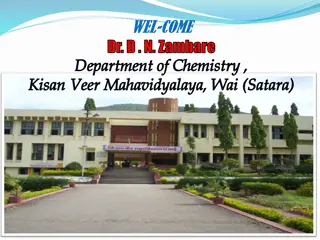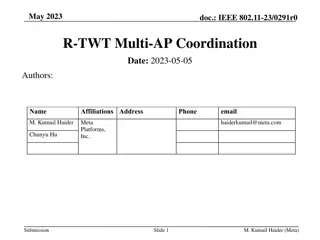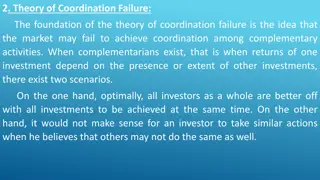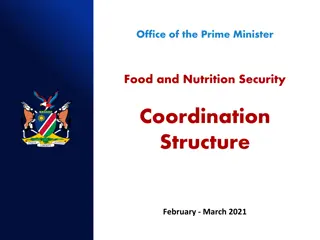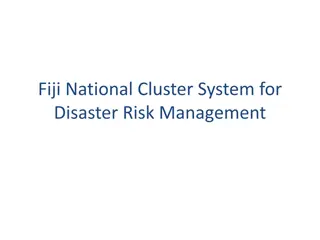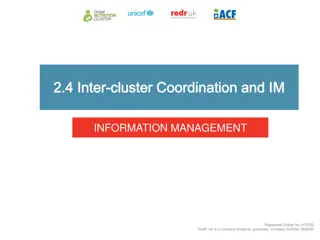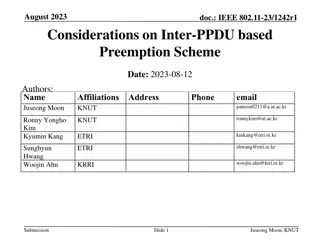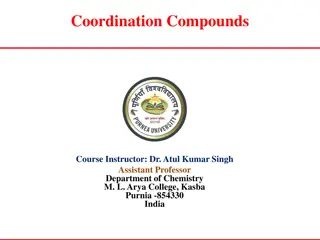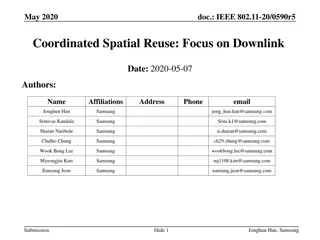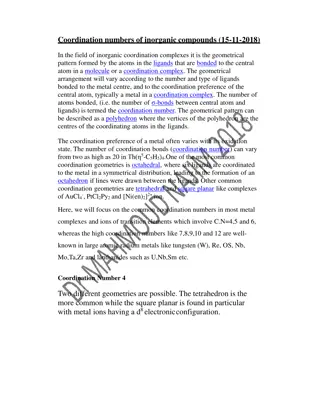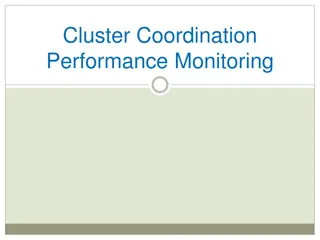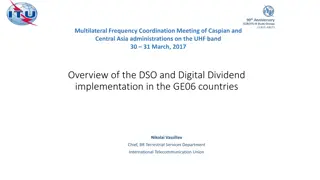
Enhancing Wi-Fi Throughput with AP Coordination Strategies
Explore considerations on Access Point (AP) coordination for improving Wi-Fi throughput in various scenarios. Learn about MAC coordination, transmission coordination, non-coherent joint transmission, and handover coordination techniques discussed in the September 2018 document.
Download Presentation

Please find below an Image/Link to download the presentation.
The content on the website is provided AS IS for your information and personal use only. It may not be sold, licensed, or shared on other websites without obtaining consent from the author. If you encounter any issues during the download, it is possible that the publisher has removed the file from their server.
You are allowed to download the files provided on this website for personal or commercial use, subject to the condition that they are used lawfully. All files are the property of their respective owners.
The content on the website is provided AS IS for your information and personal use only. It may not be sold, licensed, or shared on other websites without obtaining consent from the author.
E N D
Presentation Transcript
September 2018 doc.: 802.11-18-1576-01-0eht Considerations on AP Coordination Date: 2018-09-13 Authors: Name Affiliations Address email Bo (Boyce) Yang Nanjing, China yangbo59@huawei.com Roger Marks Denver, USA roger@ethair.net Huawei Yunping (Lily) Lyu Nanjing, China lvyunping@huawei.com Yuchen (Jason) Guo Shenzhen, China guoyuchen@huawei.com Submission Slide 1
September 2018 doc.: 802.11-18-1576-01-0eht Introduction AP coordination has been suggested in several EHT TIG contributions ([1]-[5]) with the goals of improving throughput in typical scenarios. AP coordination would be a major feature differentiating EHT from 802.11ax. AP coordination comes in many possible forms. In general, the technologies can be classified into two types: MAC coordination PHY coordination Submission Slide 2
September 2018 doc.: 802.11-18-1576-01-0eht MAC Coordination MAC-level control information exchange APs exchange MAC-level control information Frame-level time synchronization Frame synchronization, can be achieved by coordinating trigger frames without additional hardware. Tolerance of ~0.8 sec or better may be required in some scenarios Candidate approaches transmission coordination Non-Coherent Joint Transmission handover coordination interference nulling Submission Slide 3
September 2018 doc.: 802.11-18-1576-01-0eht Transmission Coordination avoid inter-BSS interference and collisions enhances spatial reuse for distant APs AP 1 AP 2 AP 3 BSS 1 BSS 2 BSS 3 BSS ID BSS 1 downlink BSS 3 downlink BSS 1 uplink BSS 3 uplink BSS 2 downlink BSS 2 uplink time slot Submission Slide 4
September 2018 doc.: 802.11-18-1576-01-0eht Non-Coherent Joint Transmission AP1 and AP2 can transmit the same data frame, without precoding, to edge user to improve the signal quality Data sharing AP2 transmits the same data frame to STA1 at the same time AP 1 AP 2 AP1 shares STA1 s data frame to AP2 beforehand STA 1 Submission Slide 5
September 2018 doc.: 802.11-18-1576-01-0eht Handover Coordination Coordination between home AP and target AP can speed handover Improves performance in, for example, warehouse and office scenarios Example exchange: 1) Home AP and target AP exchange signal strength information 2) Target AP sends handover information to home AP 3) Home AP sends Target AP handover information to STA 4) STA uses Target AP handover information for speedy association AP 1 AP 2 moving towards AP 2 STA 1 Submission Slide 6
September 2018 doc.: 802.11-18-1576-01-0eht Interference Nulling AP gathers CSI information from unassociated clients and then pre-codes to null signal there. Downlink throughput can be improved significantly in typical scenarios. PHY technique, but does not necessarily require PHY information exchange between APs . CSI from AP 1 to STA 2 is need to null interference for STA 2 CSI from AP 2 to STA 1 is need to null interference for STA 1 AP 1 AP 2 mutual nulling STA 1 STA 2 Submission Slide 7
September 2018 doc.: 802.11-18-1576-01-0eht PHY Coordination APs share data as well as control information. Joint precoding (spatial mapping) codes data for every stream in the joint transmission. Channel information exchange may be required, depending on precoding type, Data could be shared by wired or wireless link. Strict synchronization requirement Transmission time must be precisely synchronized (may require nanosecond-level time synchronization). Carrier frequency offset and Sampling Frequency Offset must be compensated precisely. Phase synchronization is also needed for joint channel estimation and joint transmission. Candidate technology Distributed MIMO Submission Slide 8
Septembew 2018 doc.: 802.11-18-1576-01-0eht Distributed MIMO Distributed MIMO (D-MIMO) coordinates a variable number of transmitters to improve throughput in typical scenarios. flexible number of spatial streams; for example, from 1 to 16 higher spectral efficiency than collocated MIMO (C-MIMO) D-MIMO could be a signature differentiated feature in EHT, as is MU-MIMO in VHT and OFDMA in HE Rx 1 Rx 2 Tx 1 Rx 3 Rx 4 Rx 5 Tx 2 Rx 6 Rx 7 Rx 8 Tx 3 Rx 9 Rx 10 Rx 11 Tx 4 Rx 12 Rx 13 Rx 14 Rx 15 Figure 2 [6] Rx 16 Note: the 3-tuple (M, L, N) means ( number of sta, number of antennas per AP, number of AP ) Figure 1 Submission Slide 9
September 2018 doc.: 802.11-18-1576-01-0eht Distributed MIMO requirements Distributed MIMO requires time, frequency and phase synchronization Distributed transmitters need to transmit their signal simultaneously while maintaining CSMA compliance. A possible approach is to specify a Joint Transmission Trigger frame used to trigger simultaneous transmission from distributed APs and sent after one transmitter obtains a channel access opportunity. Carrier and sampling frequency of distributed transmitters must be synchronized accurately to avoid OFDM inter-symbol interference Carrier frequency offset can be measured when receiving the Joint Transmission Trigger frame, then the CFO can be compensated in the baseband. Distributed transmitters can also synchronize their reference clock over the backhaul to synchronize the RF. Phase synchronization is also needed as residual frequency error can lead to large phase drift in a long time interval. Submission Slide 10
September 2018 doc.: 802.11-18-1576-01-0eht Summary We propose an overview of AP coordination candidate technologies MAC coordination is easier to achieve PHY coordination provides more opportunities to enhance performance. Submission Slide 11
September 2018 doc.: 802.11-18-1576-01-0eht References [1] Distributed MU-MIMO and HARQ Support for EHT (802.11- 18-1116-00-0eht) [2] Multi-AP Enhancement and Multi-Band Operations (802.11-18- 1155-01-0eht) [3] EHT Technology Candidate Discussions (802.11-18-1161-00- 0eht) [4] Discussion on EHT Study Group Formation (802.11-18-1180-00- 0eht) [5] Extremely High Throughput (EHT) 802.11 Study Group Creation (802.11-18-1271-00-0eht) [6] Spectral efficiency of distributed MIMO systems [J]. IEEE Journal on Selected Areas in Communications, 2013, 31(10): 2112- 2127. Submission Slide 12
September 2018 doc.: 802.11-18-1576-01-0eht Appendix: Distributed MIMO Architecture Submission Slide 13
Septemeber 2018 doc.: 802.11-18-1576-01-0eht Distributed MIMO Architecture STA 1 STA 2 DAP A single architectural AP, divided internally into a central AP-C and remote AP-Rs. Connectivity could be by Ethernet. AP-Rs are tightly synchronized and coordinated. One coordinated MU-MIMO beamforming system. No handover. STA 3 AP-R STA 4 STA 5 Distributed MU-MIMO STA 6 STA 7 AP-R STA 8 STA 9 AP -C STA 10 AP-R STA 11 STA 12 STA 13 STA 14 AP-R STA 15 STA 16 Submission Slide 14
September 2018 doc.: 802.11-18-1576-01-0eht Distributed MIMO Architecture: variations Variations of the distributed MIMO architecture, from one extreme to another: Type 1: AP-R is simply antenna plus amplifier, connected with RF cable. Type 2: AP-R contains lower PHY and analog RF. AP-C contains MAC layer functions and upper PHY. Various splits between upper and lower PHY are possible. Type 3: AP-C is a TSN-based Ethernet switch. AP-R is a full AP with D-MIMO capabilities. antenna Ethernet Switch AP AP-R AP AP-R AP -C AP AP AP-R eCPRI-like Fronthaul AP AP-R Ethernet RF Cable Type 1 Type 2 Type 3 Submission Slide 15


